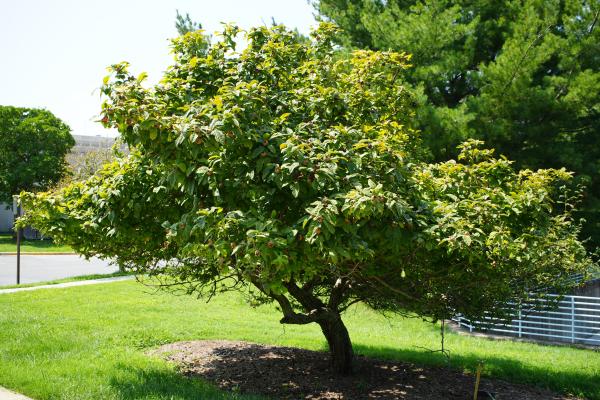Opinion: Contemplating the Colorful NIH Canopy in Fall
How the Exquisite Trees on the Bethesda Campus Support the NIH Mission
BY SEPPIDEH SAMI, CC
Take a stroll on the NIH Bethesda campus and you will encounter a tapestry of trees, including two gorgeous Champion Trees, designated as the largest of their species in Montgomery County: One is an Allegheny chinkapin near Building 45, and the other is a black willow by the Stoney Creek Pond. Many new, smaller trees dot the campus, too, planted in remembrance of patient volunteers or NIHers who have died.
The 310-acre Bethesda campus is home to some 8,500 trees, more than 160 species, mostly native to the mid-Atlantic region, according to NIH landscape architect, Connor Price. Some are quite old; some have interesting biographies; and all join the human staff in supporting the NIH mission.
Consider NIH’s two Trees of Hippocrates, said to be clones of the very tree that Hippocrates, the father of modern medicine, taught under on the island of Cos 2,500 years ago. In 1961, the Greek ambassador to the United States gifted a sapling from the Cos tree as a sign of friendship and source of inspiration.
That first tree thrived until the late 1980s, when fungal disease set in. NIH’s landscape architect at that time, Lynn Mueller, worked to save the tree to little avail. He collaborated with the nonprofit Archangel Ancient Tree Archive to identify the genetic code of the historic tree and generate two more clones. One clone was planted outside NLM in 2014; the other stands at the Clinical Center’s north entrance.

CREDIT: ERIC BOCK
This medlar tree resides on Medlars Drive on the NIH Bethesda campus. Medlars Drive is named after the MEDLARS, the MEDical Literature Analysis and Retrieval System, the precursor to Medline.
As sort of an inside joke, Mueller also planted fruiting medlar trees on Medlars Drive, the joke being that the road was named after the MEDLARS, the MEDical Literature Analysis and Retrieval System, the precursor to Medline.
Science supports the important influence of trees on the wellbeing of our planet and its inhabitants, helping to better manage human health (PMID: 32570770) and to buffer the impacts of a rapidly changing climate.
“There are many benefits to having trees nearby,” said Price, citing “sequestering carbon from the atmosphere, reducing the amount of energy used for heating and cooling buildings, and providing a great food source as well as habitat for the wildlife.”
Price oversees tree plantings, working closely with the design landscape architect team to weigh in on which species will thrive in specific areas. Sometimes, he allows exotic species without potential to be invasive, because they may be visually interesting, bear fruit for birds, or provide shelter for animals.
Price said he is building on the work of Brandon Hartz, landscape architect from 2016 to 2022, who had taken the reins from Mueller upon his retirement after 37 years of service during which he initiated the NIH reforestation program and installed numerous bluebird boxes. Hartz, among his many contributions, increased the tree plantings in the reforestation areas.
Every year, Price plants upward of 125 trees to keep up with the general loss due to severe weather events, disease, old age, or construction; more trees are planted to reach a forest conservation goal. In the forested areas, when safe, Price and his team will create a “snag” rather than remove a dying or a storm-damaged tree. They remove the tree top and branches but keep the trunk in place to serve as habitat for nesting birds and insects. The tree slowly decomposes, enriching the forest floor.
NIHers find the trees essential for work productivity. Robert Scott, a biologist in the NIMH Section on Neural Function, often takes walks among the trees after long bouts in the lab to reduce stress and improve his mood.
“While the work our lab does in understanding the mechanisms involved in the hormonal control of behavior is important to further the NIH mission, the human impact of our research often seems highly targeted and distant,” said Scott, who, as a member of an NIMH employee advisory committee, arranged two Wellness Walks in the spring of 2024. “The work that Connor and his team do is having an immediate impact on not just the health of the campus ecosystem, but, I believe, positive wide-ranging effects on the wellness of the very researchers whose goal it is to enhance health, lengthen life, and reduce illness and disability.”
Seppideh Sami is a training coordinator in the Patient Support Services Department at the NIH Clinical Center. In her spare time, she enjoys studying the conservation and preservation of the natural world, especially plants.
This page was last updated on Thursday, December 5, 2024
